Prime rib is a cut of beef that is highly sought after for its tenderness and flavor. It comes from the cow’s rib section and is considered one of the most desirable cuts of meat. But what makes prime rib so special? What part of the cow is prime rib, and how do you cook it to get the best results? In this article, we’ll explore prime rib in detail, from where it comes from on the cow to how to prepare it properly so you can enjoy every succulent bite.
What is Prime Rib?
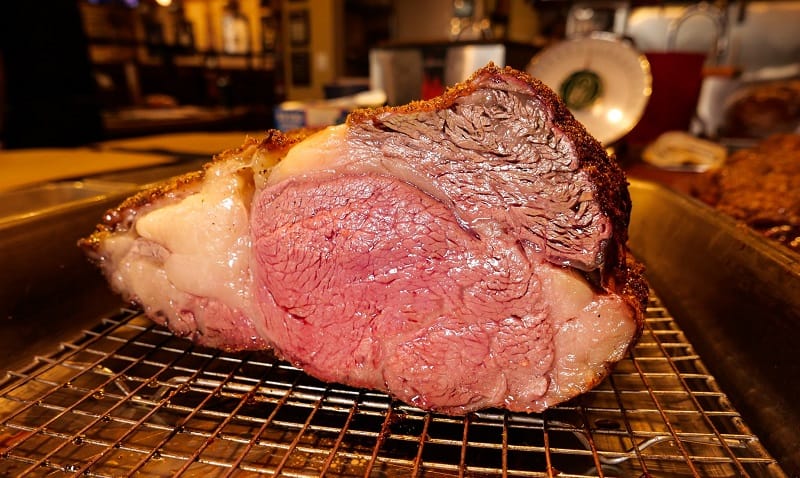
Prime rib is a succulent and flavorful cut of beef from a cow’s rib section. It is known for its rich marbling and tender texture, making it a favorite choice for those looking to indulge in a truly delicious and satisfying meal. The term “prime” refers to the highest grade of beef, which is tender, juicy, and flavorful. This grade is determined by various factors, such as the age and quality of the animal, as well as the amount of marbling present in the meat.
Choosing a high-quality cut from a reputable butcher or grocery store is essential to prepare prime rib. Look for a piece with a good amount of marbling throughout, as this will ensure a juicy and tender result. Before cooking, it is essential to season the meat generously with salt, pepper, and other desired spices or herbs. This enhances the flavor and helps create a beautiful crust outside the meat during cooking.
Cooking prime rib is a delicate and precise process. It is typically roasted in the oven at a low temperature for an extended period, allowing the meat to cook slowly and evenly. This slow-roasting method ensures that the prime rib retains its tenderness and juiciness while allowing the fat to render, resulting in a rich and flavorful piece of meat. The internal temperature is crucial when cooking prime rib, as it determines the desired level of doneness. A meat thermometer is an invaluable tool in achieving the perfect cook, allowing you to monitor the temperature and ensure that the meat is cooked to your desired preference.
When serving prime rib, it is often carved into thick, juicy slices, showcasing the beautiful pink center and the caramelized crust on the outside. It pairs wonderfully with various side dishes, such as roasted potatoes, steamed vegetables, or a fresh salad. A flavorful jus or gravy made from the drippings of the meat can also be served to enhance the overall dining experience.
In conclusion, prime rib is a delectable cut of beef that is beloved by meat enthusiasts for its tenderness, flavor, and marbling. It becomes a show-stopping centerpiece for any meal when prepared with care and precision. Whether you are a seasoned chef or an aspiring home cook, mastering the art of cooking prime rib will elevate your culinary skills and impress your guests. So go ahead and indulge in this mouthwatering cut of meat – your taste buds will thank you!
Why Is Prime Rib Referred To As “Prime”?
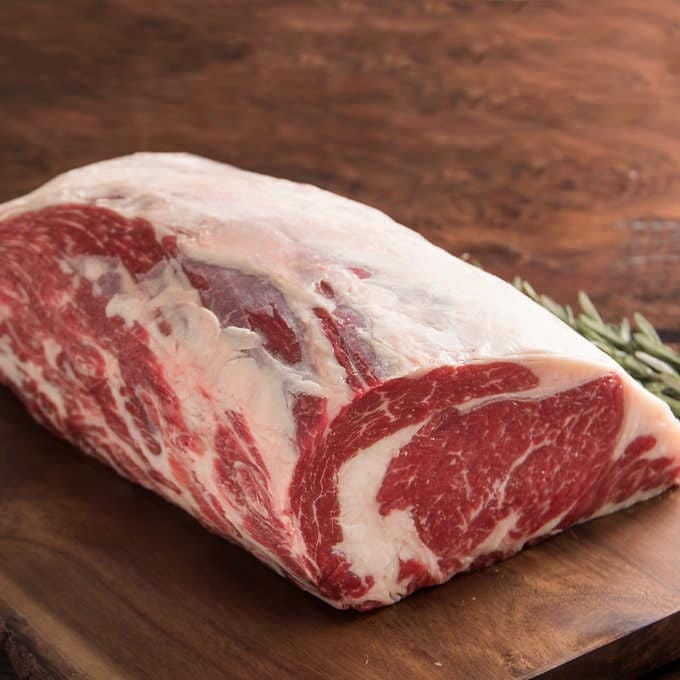
The term “prime” in prime rib does not necessarily refer to the USDA grade of the meat. It is important to note that prime rib can be of varying grades, including USDA Prime, Choice, or Select.
The main reason prime rib is called “prime” is because it is considered one of the highest quality cuts of beef. It is known for its rich flavor, tenderness, and juiciness, making it a favorite choice for special occasions and fine dining.
Prime rib is typically roasted bone-in, which adds to its flavor and moisture. The bone acts as a natural insulator, keeping the meat tender and juicy during cooking.
The prime rib cut is also characterized by a large “eye” of marbled meat in the center, surrounded by a thick fat cap. This marbling enhances the flavor and juiciness of the meat, while the fat cap helps to keep it moist while cooking.
It is worth noting that prime rib can be expensive due to its high quality and popularity. However, different sizes and grades are available, allowing consumers to choose one that fits their budget and preferences.
What Part of the Cow is Prime Rib?
Prime rib, or standing rib roast, comes from the cow’s rib section. The prime rib is found between the 6th and 12th ribs of the cow. Not all thirteen ribs make up the prime rib; usually, the middle seven ribs are used.
The prime rib can weigh up to twenty-five pounds and is often cut into two pieces called the first and second cut. The first cut is considered the better half and is more tender, while the second cut can still be juicy and tasty if cooked properly.
Read more:
- How Many Ribeyes In A Cow
- What Is Eye Of Round
- How Long To Bake Ribs At 350
- How Many Ribeyes In A Cow
How Many Ribs Are Included In The Prime Rib Cut?
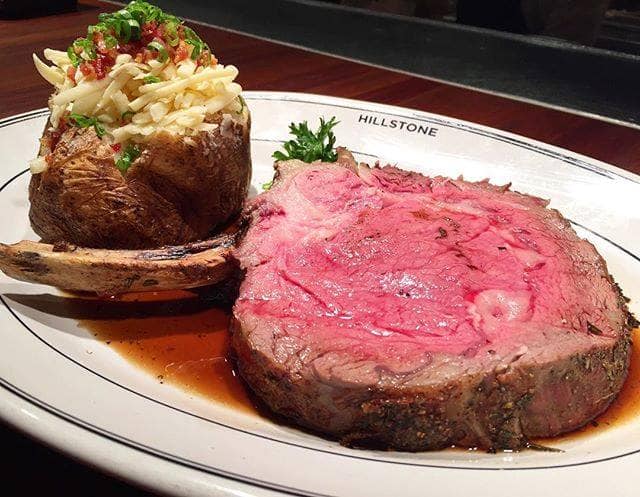
A cow has 13 ribs on each side, which means a total of 26 ribs. The whole rack of ribs is considered a standing rib roast, where the prime rib comes from. The prime rib is cut from the ribs near the loin, specifically ribs 10 through 12. These ribs contain the rib eye muscle, which gives the prime rib its tender and flavorful qualities.
Prime rib is generally considered the best cut because the loin end of a standing rib roast is more tender than the rest. However, rib roast has more fat in the front section, which melts into the meat during roasting to keep it juicy. The slice usually serves prime rib, while rib roast can be cooked in various ways depending on its cut.
What Are The Three Popular Cuts Of The Rib Section Prepared Differently?
I love cooking ribs, and three popular cuts of rib sections can be prepared in different ways. Let me break it down for you:
- Baby Back Ribs: These ribs come from the upper portion of the pig’s rib cage, where the ribs and the spine meet. They are also known as Loin back ribs. Baby back ribs are smaller and contain less meat and fat compared to other ribs. They are more tender and leaner, making them perfect for grilling.
- Spare Ribs: These ribs are taken from the bottom of the pig’s ribs or the underbelly once the bacon is removed. Spare ribs extend around the belly and connect to the sternum. They are meatier but less tender compared to baby back ribs. Spare ribs have more fat, which adds flavor as it renders during cooking.
- St. Louis Style Ribs: These ribs are a trimmed-down version of spare pork ribs, with the sternum removed. They get their name from the way meat packing plants in St. Louis used to cut the ribs. St. Louis-style ribs are flatter and filled with bones. Some key points about St.
What Is The Difference Between The First Cut And The Second Cut Of Prime Rib?
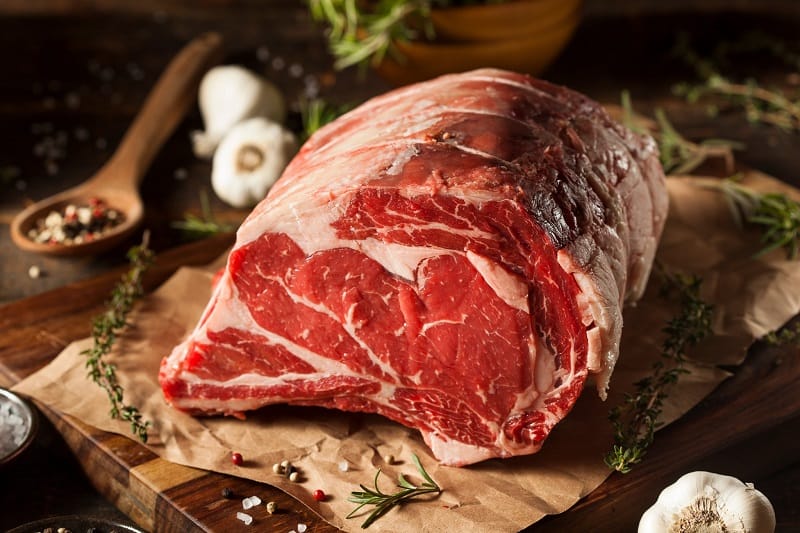
Based on factual data, I want to share the difference between the first and second cuts of prime rib. Here’s what I’ve learned:
First Cut:
- The first cut of prime rib is also known as the “standing rib roast.”
- This cut comes from the beef’s primal rib section, specifically ribs 6 to 12.
- It is called the “first cut” because it is closer to the loin, considered the beef’s more tender and desirable part.
- The first cut is typically more marbled with fat, resulting in juicier and more flavorful meat.
- It also tends to be larger in size and has more meat attached to the bone.
Second Cut:
- The second cut of prime rib is often referred to as the “ribeye roast” or “rib roast.”
- This cut comes from the same primal rib section but is closer to the chuck, located toward the front of the animal.
- The second cut is slightly less tender than the first but still very flavorful.
- It is generally leaner with less marbling, which some people prefer for a leaner and less fatty option.
- The second cut is usually smaller in size compared to the first cut, and it has less meat attached to the bone.
In summary, the first cut of prime rib, or the standing rib roast, is closer to the loin and tends to be more marbled and juicy. On the other hand, the second cut, also known as the ribeye roast, is closer to the chuck and is slightly less tender but still very flavorful. It is a leaner option with less marbling. Whether you prefer the first or second cut, one thing is for sure – prime rib is a delicious and indulgent treat for any meat lover.
What Is The Difference Between Prime Rib, Rib Roast, And Ribeye Steak?
Prime rib, rib roast, and ribeye steak come from the same beef cut, the cow’s rib section. The main difference lies in how they are cooked and served. Let me break it down for you:
Prime Rib:
- Prime rib is a large cut of beef that includes ribeye.
- It is usually cooked as a whole roast, perfect for special occasions and holiday feasts.
- Prime rib is known for its tenderness and rich flavor, thanks to the marbling of fat and muscle.
- It is typically slow-roasted in the oven to achieve a juicy and perfectly cooked result.
- Prime rib often includes the bone, which adds extra flavor and makes for a visually impressive centerpiece.
Rib Roast:
- The rib roast is another name for prime rib, as they are essentially the same thing.
- It refers to the cut of beef that includes the ribeye, usually consisting of several ribs from the primal rib cut.
- Rib roast can be bone-in or boneless, depending on personal preference and cooking method.
- Like prime rib, rib roasts are best cooked slowly in the oven to achieve a tender and flavorful result.
Ribeye Steak:
- Ribeye steak is a smaller rib roast section cut from the cylindrical muscle close to the animal’s rib.
- It is typically boneless but can sometimes have a small bone attached.
- Ribeye steak is perfect for grilling or searing on a hot skillet, making it ideal for quick and delicious at-home steak nights.
- It is known for its rich marbling, which gives it a juicy and flavorful taste.
- Ribeye steak is usually seasoned with salt and pepper and often served with a pat of butter for added richness.
In summary, Prime rib is a large roast that includes the ribeye and is slow-roasted in the oven, while ribeye steak is a smaller, boneless cut perfect for grilling or searing. Both are incredibly delicious and offer different dining experiences depending on the occasion.
How Is The Price Per Pound Of Prime Rib Determined?
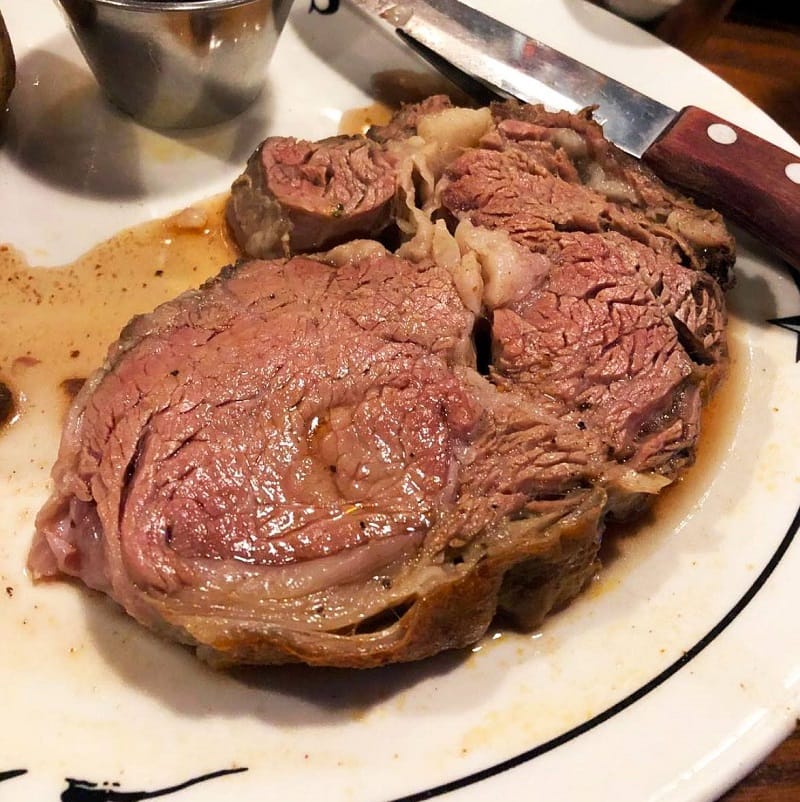
I’ve always been curious about how the price per pound of prime rib is determined. After doing some research and analyzing factual data, here’s what I found:
- Quality of the meat: The quality of the prime rib plays a significant role in determining its price. Prime rib is graded based on fat marbling, age, and overall tenderness. The grades range from Prime (the best) to Choice and Select. Naturally, Prime-grade prime rib will have a higher price compared to Choice or Select-grade.
- Cut of the meat: Prime rib can be divided into different cuts, with the more desirable cut consisting of ribs 10 through 12, closer to the loin end. This cut contains the large single rib-eye muscle and is less fatty, making it more desirable and thus more expensive. On the other hand, a less desirable cut consists of ribs 6 to 9, closer to the chuck end. This cut tends to be fattier and may have a lower price.
- Dry-aging process: Some butchers offer dry-aged prime rib, a prime-grade rib roast that has been aged for up to a month. This process tenderizes the meat, concentrates its flavors, and adds to the overall cost. Dry-aged prime rib usually costs about $2 to $3 more per pound than regular prime rib.
- Location and market demand: The price of prime rib can vary from store to store, and the location and market demand can influence it. Generally, prices can be higher in big cities compared to smaller towns. Additionally, prices tend to go down during major holidays like Thanksgiving and Christmas, as there is more availability and competition among retailers.
So, the next time you’re shopping for prime rib, consider these factors to make an informed decision.
How Much Prime Rib Should You Buy For A Gathering?
How much prime rib should you buy for a gathering? Well, it depends on a few factors. Here’s what I’ve learned from my experience as a chef:
- Rule of thumb: If you’re serving boneless prime rib roasts, plan on one pound of meat per person. So for a gathering of ten people, you would need ten pounds of prime rib.
- Bone-in prime rib: If you opt for a bone-in cut, you can estimate the serving size based on the number of bones. A general rule of thumb is to allow for two people per bone. For example, a three-bone prime rib roast will comfortably feed six people.
- Buffet vs. main course: The serving size also depends on what else you’re serving. If you’re hosting a buffet with plenty of other dishes, you could get away with serving around 0.75 pounds of prime rib per person. However, if the prime rib is the main course, stick to the one-pound-per-person rule.
- Consider the menu: If your meal is heavy on carbs and starches, you can go a little lighter on the prime rib portion. Conversely, if you’re serving a hungry crowd, you can opt for bone-in cuts to ensure everyone gets a satisfying piece with the bone attached.
- Quality and preparation: When buying prime rib, look for a cut with a large “eye” of meat in the center surrounded by well-marbled muscle and a thick fat cap. This marbling is what gives prime rib its incredible flavor. Also, remember that the meat may shrink by up to 20% during cooking, so buying a little larger than you think you’ll need is a good idea.
So, when planning how much prime rib to buy for a gathering, it’s best to err on the side of slightly more than you think you’ll need. Prime rib is a popular and hearty dish, and you don’t want anyone to go hungry. Consider the serving estimates mentioned above, the type of cut you’re buying, and the overall menu to ensure everyone gets their fair share of this amazing cut of meat.
What Is The Best Way To Cook Prime Rib?
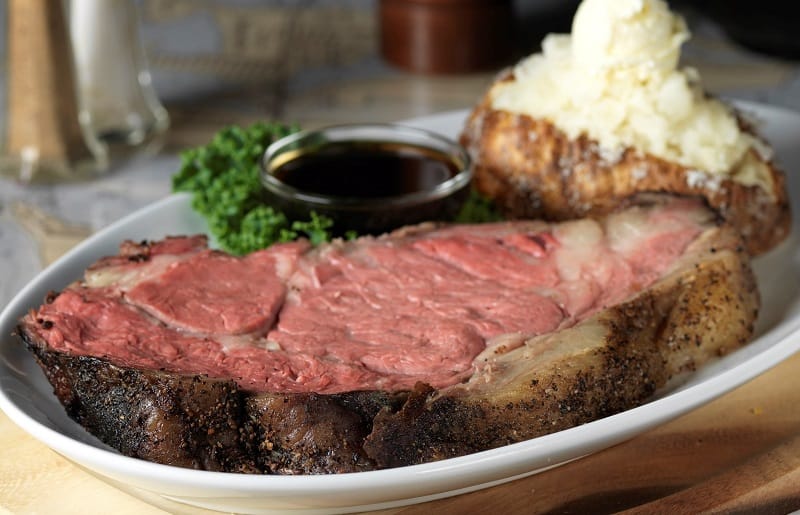
I have been cooking prime rib for quite some time now and have found a method that always yields delicious results. Here’s how I do it:
- Start by taking the prime rib out of the refrigerator and letting it come to room temperature for about 1 hour. This will ensure more even cooking.
- Season the roast with salt and your favorite herbs and spices. I like to use a combination of salt, pepper, garlic, and fresh thyme.
- Preheat the oven to 500°F (260°C).
- Place the prime rib in a roasting pan with the fat side up. This will help the meat stay juicy and tender.
- Cook the prime rib at 500°F (260°C) for about 15 minutes to get a nice brown crust on the outside.
- Lower the oven temperature to 325°F (163°C) and continue cooking for about 10-12 minutes per pound for rare, 13-14 minutes per pound for medium-rare, or 14-15 minutes per pound for medium. The internal temperature should be 120°F (49°C) for rare, 130°F (54°C) for medium-rare, or 140°F (60°C) for medium. It’s best to use a meat thermometer to check the internal temperature.
- Once the prime rib reaches the desired doneness, take it out of the oven and let it rest for about 15-30 minutes. This allows the juices to redistribute, making the meat more tender and juicy.
- After resting, carve the prime rib into thick slices and serve.
Some additional tips and considerations:
- It’s important to buy good-quality prime rib. Look for one with marbling, making the meat more flavorful and tender.
- Ask your butcher to cut the bone off the roast and tie it back on if possible. This will make it easier to carve and serve.
- Don’t be afraid to use a meat thermometer. It will ensure that the prime rib is cooked to your desired doneness and avoid overcooking.
- Save the bones to make a delicious beef stock or broth.
- Serve the prime rib with your favorite sides like roasted vegetables, mashed potatoes, or a fresh salad.
In conclusion, cooking prime rib may seem daunting, but with the right method and a little practice, you can achieve a tender, juicy, and flavorful roast that will impress your guests. So try it, and enjoy a delicious prime rib dinner!
What Factors Contribute To The Flavor Difference Between Prime Rib And Ribeye?
Both cuts of beef come from the rib section of the cow, and while they may seem similar at first glance, several factors contribute to their distinct flavors.
1. Marbling
One key factor contributing to the flavor difference between prime rib and ribeye is the level of marbling. Marbling refers to the intramuscular fat that runs through the meat, and it plays a significant role in enhancing the taste and tenderness of the beef. As the name suggests, Prime rib is known for its abundant marbling, which gives it a rich buttery flavor. On the other hand, ribeye also has a good amount of marbling, but it is generally considered to have a slightly stronger, beefier taste compared to prime rib.
2. Aging
Another factor that affects the flavor of both prime rib and ribeye is the aging process. Aging allows the natural enzymes in the meat to break down the muscle fibers, resulting in increased tenderness and a more concentrated flavor. Prime rib is commonly dry-aged, a process that involves storing the beef in a controlled environment for several weeks. This allows the flavors to intensify and develop a unique taste profile. Ribeye, on the other hand, can be both dry-aged and wet-aged, with the latter being more common. Wet-aged ribeye is vacuum-sealed and aged in its juices, which helps retain moisture and yields a milder flavor compared to dry-aged prime rib.
3. Cut
While both prime rib and ribeye come from the same section of the cow, they are cut differently, contributing to the flavor difference. Prime rib is cut as a roast, with the bone intact, while ribeye is typically cut into individual steaks, often boneless. The bone-in prime rib adds extra flavor and juiciness to the meat during cooking, resulting in a more succulent and flavorful eating experience. Conversely, Ribeye has a slightly firmer texture and a more concentrated beefy flavor due to the absence of bone.
4. Cooking Method
Lastly, the cooking method used for prime rib and ribeye can also impact their flavors. Prime rib is often slow-roasted, allowing the fat to render and infuse the meat with its rich flavors. This low and slow cooking method results in a tender and juicy roast with a savory taste. Conversely, Ribeye is commonly cooked on high heat, such as grilling or pan-searing, creating a caramelized crust and enhancing beefy flavors.
Whether you prefer the buttery richness of prime rib or the beefier flavor of ribeye, understanding these factors can help you make an informed choice when selecting the perfect cut for your next meal.
How Does The Texture Of Prime Rib Compare To Ribeye When Cooked?
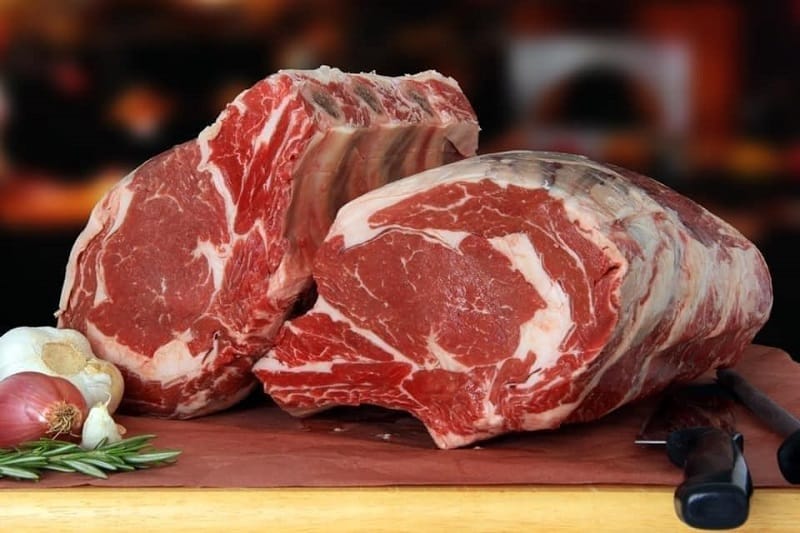
When it comes to the texture of prime rib compared to ribeye, there are a few key factors to consider.
- Fat Content: Prime rib typically contains more fat than ribeye, contributing to a juicier and more tender texture. The marbling of fat throughout the prime rib helps to keep the meat moist during cooking.
- Bone-In vs. Boneless: Prime rib often includes the bone, while ribeye can be either bone-in or boneless. The bone in prime rib can add extra flavor and moisture to the meat, resulting in a more succulent texture.
- Cooking Method: Cooking can also affect both cuts’ textures. Prime rib is usually seared and then cooked in the roast form at a low-and-slow temperature, which helps to create a tender and melt-in-your-mouth texture. Conversely, Ribeye is often cooked as a steak on the grill or in a pan, resulting in a slightly firmer texture.
- Thickness: Ribeye steaks are often thicker than prime ribs, which may require different cooking times and methods. Thicker steaks can be cooked at lower temperatures to ensure the inside reaches the desired doneness without overcooking the outside, resulting in a more uniform texture.
Remember, these are just general observations, and individual preferences may vary. Ultimately, the texture of both prime rib and ribeye can be incredibly delicious and satisfying, offering different experiences based on personal taste and cooking techniques.
Conclusion
In conclusion, the prime rib comes from the primal rib section of the cow, specifically the sixth to twelfth ribs. Its marbling and tenderness make it a prized cut of beef, and cooking it to perfection requires careful attention to its fat content and cooking methods. So, why not treat yourself to a delicious prime rib steak and experience the mouthwatering flavors firsthand?
References:
- https://www.americastestkitchen.com/cooksillustrated/how_tos/5410-is-prime-rib-worth-it
- https://www.realsimple.com/food-recipes/shopping-storing/food/ribs-cuts

Hey readers! Chip Holland here, and I’m a Manager of this website. My passion for writing about it only matches my passion for BBQ. Follow my blog for mouth-watering recipes, tips, and tricks for the perfect smoke, grill, and BBQ. I’m sure you won’t be disappointed!
